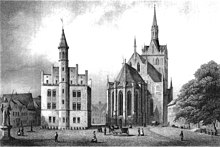St. Jakobi (Perleberg)
Sankt Jakobi (also: Sankt Jacobi ) is the Protestant parish church of Perleberg , the district town of the Prignitz district in the state of Brandenburg .
history
Not much is known about the construction of the St. Jakobikirche. What is certain is that it was built later than St. Nikolaikirche, which was demolished in the 18th century. Its oldest remains are the tower base, the east wall with the triumphal arch and the foundations of the choir , which suggests that the first construction phase with the tower and the choir began in field stone . Investigations into the noticeable change in material from field stone to brick in the early construction phase suggest that the first construction took place between 1280 and 1290. St. Jakobi is mentioned for the first time in a deed of foundation from 1294, in which a Heinrich Normann "gives the two churches in Perleberg a lift to wine and wafers". After indulgences for the church in 1295 and 1321, the dressmakers donated an altar in 1324 and the Marian Guild in 1332. The three-aisled and four-bay brick hall, whose basic shape was built between 1320 and 1335, got its roof in the 1330s. Of the four present-day portals of the nave , only the southwestern one originally existed, which had an equivalent on the north side. In the 15th century the portal on the north side was apparently replaced and two new ones were added in the south-east and north-east. The extension of the choir, which is probably a new building on the remains of an older one, can be dated to the year 1361, which is an inscription on the outer north wall.
Presumably in the first half of the 15th century, the church tower was raised and the bell storey, which is still preserved today, was built. In the same century, the three-lane, late Gothic windows were installed and some of the reveals were decorated with motifs such as images of the Apostles. The latter, however, was possibly removed by plastering in 1912. Furthermore, a sacristy was built in the southern area of the choir and a Marienkapelle in the northern area, but these were removed by restorers after 1850 together with chapel extensions on the north side of the nave.
1517/1518 St. Jakobi received four bells (St. Catherine Bell and Sunday bell, the apostles bell [1537 Hamburg sold], the clamp bell [1823 shattered and replaced in 1824] and the Marie Bell) that the City Council in Bell Master Heinrich von Kampen from Lübeck had commissioned.
During a visitation by Bishop Daniel Amadeus Neander in 1847, considerable structural and aesthetic defects were discovered. The Prussian master builder Friedrich August Stüler was commissioned in the 1850s to restore the interior and exterior of the church. As a result, not much has been preserved of the original architecture and the baroque interior. Stüler caused u. a. to build in a portal each in the choir and tower, which made the portals on the sides of the nave superfluous. In addition, in 1854 he replaced the hipped roof with its half-timbered turrets with a gable roof and a three-tiered spire, so that the tower was about 80 m high. As in 1632, the church tower burned down on November 27, 1916 due to a lightning strike. The lost spire was replaced by a gable roof, so that the height is 49 m today. The five bronze bells were also destroyed in the fire. At the beginning of the 20th century, today's stained glass windows were installed, which were designed by the German architect Curt Steinberg , who was also responsible for restoration work in 1912/13, and were largely implemented by Berlin-based Gottfried Heinersdorff .
inventory
Not much has been preserved from the former inventory. There are still the Gothic choir stalls and the Levite seat , both of which date from around 1400, as well as a large five-armed brass chandelier made in 1475 by the Hamburg foundry Harmen Bonstede. There are also chandeliers in the central nave, one of which is of baroque origin (1685), and an epitaph of the mayor Konow. The organ builder Johann Friedrich Turley , son of the baker and organ builder Johann Tobias Turley , built his second largest organ with 36 stops here in 1831 .
literature
- Franz Grunick: Chronicle of the district and garrison town of Perleberg. Verlag F. Grunick Nachf., Perleberg 1939, DNB 573591148 , p. 137ff.
- Dieter Hoffmann-Axthelm : St. Jakobi in Perleberg. The building history. Berlin 2010, ISBN 978-3867320849 .
Web links
- Entry in the monument database of the State of Brandenburg
- St. Jacobi Church on the website of the Evangelical Church District Prignitz
- Perleberger rhyming chronicle: The St. Jacoby Church , poem by August Höpfner
- Perleberger rhyming chronicle: Sankt Jakob , poem by August Höpfner
Individual evidence
- ^ Dieter Hoffmann-Axthelm: St. Jakobi in Perleberg. The building history. Berlin 2010, ISBN 978-3867320849 , p. 18.
- ↑ Explanations cf. Dieter Hoffmann-Axthelm: St. Jakobi in Perleberg. P. 21
- ^ Adolph Friedrich Johann Riedel : Codex diplomaticus Brandenburgensis . Vol. 1, Berlin 1838, p. 124 ( online )
- ^ Franz Grunick: Chronicle of the district and garrison town of Perleberg. P. 13.
- ^ Dieter Hoffmann-Axthelm: St. Jakobi in Perleberg. P. 23.
- ^ Dieter Hoffmann-Axthelm: St. Jakobi in Perleberg. P. 34ff.
- ^ Dieter Hoffmann-Axthelm: St. Jakobi in Perleberg. P. 43.
- ^ Dieter Hoffmann-Axthelm: St. Jakobi in Perleberg. P. 47ff.
- ^ Dieter Hoffmann-Axthelm: St. Jakobi in Perleberg. P. 51ff.
- ↑ a b c d St. Jacobi on the pages of the Protestant church district Prignitz , accessed on July 21, 2013
- ^ Dieter Hoffmann-Axthelm: St. Jakobi in Perleberg. P. 49f.
- ^ Dieter Hoffmann-Axthelm: St. Jakobi in Perleberg. P. 51
Coordinates: 53 ° 4 ′ 37 " N , 11 ° 51 ′ 41.4" E



